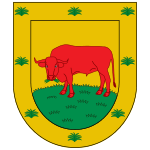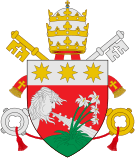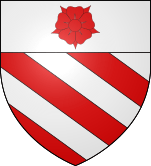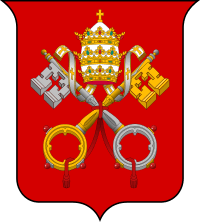Papal nobility
The Papal nobility is the nobility of the Holy See. Few Pontifical titles, other than personal nobility granted by individual entry into the several Pontifical equestrian orders, have been granted since the election of Pope John XXIII, though Pope John Paul II ennobled several distinguished individuals during his pontificate, as did Pope Benedict XVI, through the Vatican Secretariat of State. Those granted included prince, duke, marquis, count, and baron. The papal nobility are, as such, part of the Papal Court reformed via the 1968 apostolic letter Pontificalis Domus, which reorganized the Court into the Pontifical Household. Papal titles of nobility were specifically recognized by Italy in the 1929 Lateran Treaty establishing the Vatican City State and recognizing the sovereignty of the Holy See. In 1969 the Italian Council of State determined that the provision of the Lateran Treaty concerning the recognition of papal titles that was incorporated into the Italian Constitution was still valid and therefore that their use in Italy was still licit. No provision, however, has been made for their use in Italian passports, identity cards or civil state registries.
History
The Papal States under the temporal jurisdiction of the Pope had a territorial nobility, allied and intermarried with the nobility of other Italian states. During this period, throughout Italy, various influential families came to positions of power through the election to the papacy of a family member or were elevated into the ranks of nobility through ecclesiastic promotion. These families freely intermarried with aristocratic nobility. Like other noble families, those with both papal power and money were able to purchase comunes or other tracts of land and elevate family patriarchs and other relatives to noble titles. Hereditary patriarchs were appointed Duke, Marquis and even Prince of various 16th- and 17th-century principalities. According to Ranke:
Under Innocent X, there existed for a considerable time, as it were, two great factions, or associations of families. The Orsini, Cesarini, Borghese, Aldobrandini, Ludovisi, and Giustiniani were with the Pamphili; while opposed to them, was the house of Colonna and the Barberini.
— Leopold von Ranke, The History of the Popes
Popes commonly elevated members of prominent families to the position of cardinal; especially second and third sons who would not otherwise inherit hereditary titles. Popes also elevated their own family members – especially nephews – to the special position of cardinal-nephew. Prominent families could purchase curial offices for their sons and regularly did, hoping that the son would rise through Church ranks to become a bishop or a cardinal, from which position they could dispense further titles and positions of authority to other family members.[1]
The period was famous for papal nepotism and many families, such as the Barberini and Pamphili, benefited greatly from having a papal relative. Families that had previously been limited to agricultural or mercantile ventures found themselves, sometimes within only one or two generations, elevated to the Roman nobility when a relative was elected to the papal throne.[1] Modern Italy is dotted with the fruits of their success – various family palazzi remain standing today as a testament to their sometimes meteoric rise to power.
After the Kingdom of Italy annexed the Papal States and captured Rome in 1870, the pope remained a self-described "prisoner in the Vatican", supported by the "black nobility" of families who remained loyal to the papacy rather than the Italian monarchy. The Lateran Treaty ended the dispute and made the Papal nobility a part of the Italian nobility until the 1946 abolition of the Italian monarchy.
As most of the Papal States were annexed by the Kingdom of Italy in 1870, the new kingdom recognized the existing nobility in its new territory. On the occasion of the signing of the Lateran Accords of 1929, the Italian government recognized and confirmed the pope's power to grant noble titles, and recognized the titles granted by the Pope until that date and all future titles as equivalent to the noble titles of the Kingdom of Italy. With Paul VI, declaring in 1968 that the papal nobility would no longer be a constituent body in the papal court, the custom of conferring noble titles such as Count, Marquis, Duke or Prince essentially disappeared. Pope John Paul II did grant several noble titles to Polish compatriots at the beginning of his pontificate, but quietly and without their being published in the Acts of The Apostolic See. The popes continue to award knighthoods and medals of merit on a regular basis, which do not confer titled-nobility status with the exception of Count of the Sacred Palace of the Lateran.[2]
Papal counts and countesses
Count/Countess is one of the noble titles granted by the Pope as a temporal sovereign, and the title's holder is sometimes informally known as a papal count/papal countess or less so as a Roman count/Roman countess, but mostly as count/countess. The comital title, which can be for life or hereditary, has been awarded in various forms by popes and Holy Roman Emperors since the Middle Ages, infrequently before the 14th century, and the pope continued to grant the comital and other noble titles even after 1870, when the Papal States were taken from the pope.
Recipients of such honours included both Italians, especially those close to the papacy (some of whom were/are papal relatives), and prominent non-Italian Catholics, including Irish tenor John McCormack, American financier George MacDonald, American philanthropist Katherine E. Price, and Rose Kennedy (mother of U.S. president John F. Kennedy). American Francis Augustus MacNutt was a papal marquis and Argentine Mercedes Castellanos de Anchorena was a papal marchioness, and in the 1920s, Genevieve and Nicholas Frederic Brady of New York were granted papal dukedoms. Pontifical noble titles, like entry motu proprio into Pontifical Equestrian Orders of Chivalry, are in the personal gift of the pope, and the grant of these titles is not recorded in the Acts of The Holy See.
Count of the Sacred Palace of the Lateran
The title "Count of the Sacred Palace of the Lateran" is an honour that is granted 'ex officio' and 'ad vitam' to those who have been created Pontifical Chamberlains (now styled as Gentlemen of His Holiness) at attendants to the Pontifical Court. Additionally, the honour was collectively granted to the Spanish chapters of the Order of the Holy Sepulchre, the only purely noble chapters of the order. Their members enjoy several heraldic privileges in addition to the right to use the Comital title. This tradition can be traced back to the Reconquista, in which the Order played an important role. According to heraldic expert Lord Manuel de Mata, the Spanish Members of the Order are allowed to use both the full title of Count of the Sacred Palace of the Lateran as well as just the title of Count before their names. The rights were recorded in the "Memorias de la Academia Mallorquina de Estudios Genealógicos" and approved by King Alfonso XIII of Spain.[3]
Noble houses
Examples of Italian noble houses of the papacy:
| Noble House | Coat of Arms | Current Head | Titles |
|---|---|---|---|
| House of Aldobrandini | Camillo Aldobrandini | Prince of Meldola and Sarsina | |
| House of Barberini | Francesco Barberini | Prince of Palestrina
Prince di Valmontone Duke of Monterotondo | |
| House of Borghese | Scipione Virginio Flavio Giacomo Antonio Maria | Numerous Titles | |
| House of Borgia |  |
Extinct in 1748 | Numerous Titles |
| House of Borromeo | Vitaliano XI | Prince of Angera
Marquess of Romagnano Count of Arona Count of Peschiera | |
| House of Braschi |  |
Giovanni Angelo Theodoli-Braschi, | Holy Roman Empire Prince Duke of Nemi Prince of Rocca Sinibalda Marquis of Belmonte Sabino Count of Falcino |
| House of Chigi | Mario Chigi | Holy Roman Empire Prince
Prince of Campagnano | |
| House of Colonna |  |
Federico Colonna (Paliano line)
Mirta Barberini-Colonna (Carbognano line) |
Prince assistant to the Papal throne |
| House of Cybo | Extinct in 1790 | Prince of the Holy Roman Empire
Prince of Massa and Marquis of Carrara Duke of Massa e Prince of Carrara Duke and Marquis of Aiello | |
| House of Mattei |  |
Extinct in 1801 | Duke of Giove |
| House of Medici |  |
3 cadet branches | Grand Duke of Tuscany
Duke of Urbino |
| House of Orsini |  |
Domenico Napoleone Orsini | Prince Assistant to the Papal Throne
Duke of Bracciano Count of Pitigliano |
| Doria-Pamphili-Landi | Extinct in 2000 | Prince of Melfi
Duke of Montelanico | |
| House of Ruspoli |  |
Francesco Ruspoli | Prince of the Holy Roman Empire
Prince of Cerveteri Marquis of Riano Count of Vignanello |
See also
- Nobility of Italy
- Noble Guard (Vatican)
- Prince Assistants to the Papal Throne
- Papal orders of knighthood
References
- History of the popes; their church and state (Volume III) by Leopold von Ranke (2009, Wellesley College Library)
- Philippe Levillain, ed. John W. O'Malley, tr. The Papacy: An Encyclopedia (2002) vol. ii s.v. "Nobility, Roman".
- de Mata, Manuel (1955). "Breve resena de la Orden del Santo Sepulcro presentada a S.M. el Rey D. Alfonso XIII el 25 de julio de 1904 por el Excmo. Sr. D. manuel de Mata". Memorias de la Academia Mallorquina de Estudios Genealógicos (in Spanish). 1–4: 136–143.


